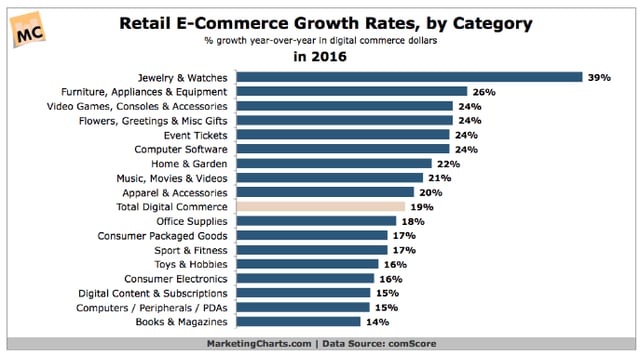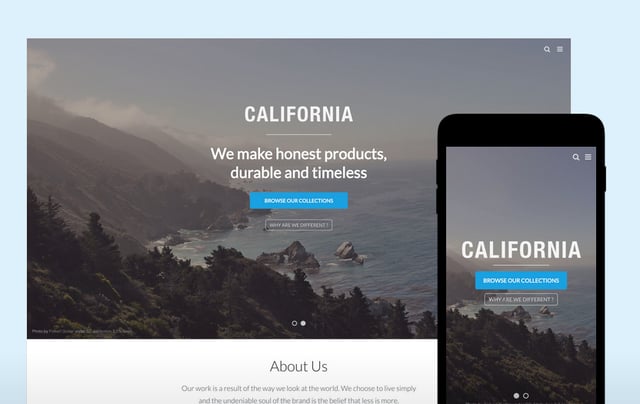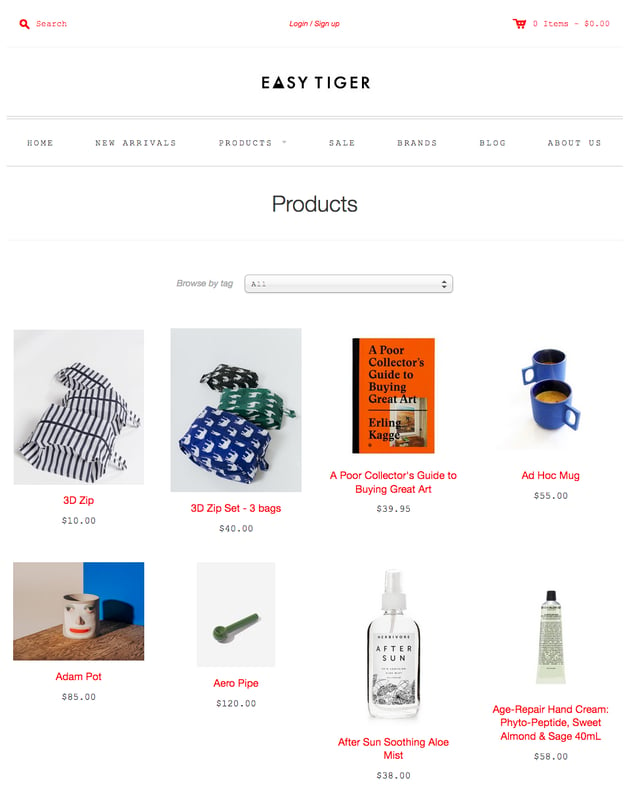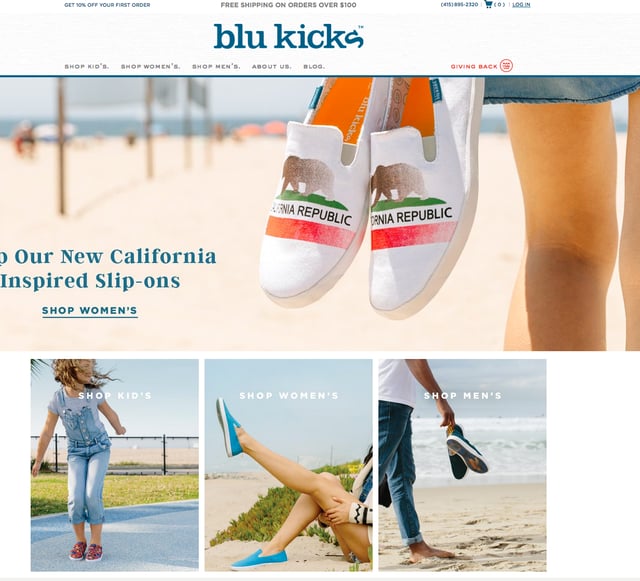The first ecommerce sale was made in 1994 … and can you guess what it was?
It was a Sting CD.
Dan Kohn, a 21-year-old who ran a website called NetMarket, sold Sting’s Ten Summoner’s Tales CD to a friend who purchased it with his credit card for $12.48 plus shipping costs. These exchanges are what we know as ecommerce today: Sales of services and goods made through the internet.
Ecommerce has come a long way since 1994, and it’s growing as more shoppers turn to devices and computers as the primary tools for discovering and buying new products. Let’s take a deeper look at what ecommerce is and the growth trends around it, as well as some basic getting started tips.
Ecommerce Trends in 2018
The biggest trend around ecommerce right now is growth — and that growth extends far and wide.
U.S. Ecommerce Growth
Ecommerce has seen tremendous growth within the U.S. in the last 10 years. In fact, data from the U.S. Department of Commerce shows that in 2017, U.S. ecommerce sales grew faster than it had since 2011 and that it represented 49% of the growth in total retail sales. That growth trend isn’t slowing down, either. Statista data predicts that ecommerce revenue will surpass $638 billion in the U.S. by 2022.

Global Ecommerce Growth
Global ecommerce is rapidly growing, too. Emarketer trend data indicates that retail ecommerce sales may exceed $4.058 trillion by as soon as 2020. As more shoppers look for products across borders and from international marketplaces, an uptick in ecommerce sales is evident around the globe.
The Nielsen Connected Commerce report said, “Shoppers are increasingly looking outside their country’s borders, as 57% of online respondents in the study who made an online purchase in the past six months say they bought from an overseas retailer.”
Ecommerce Growth by Category
ComScore data indicates there are a few particular industries seeing rapid change in regard to retail ecommerce growth. Jewelry and watches was at the top of the growth chart (as of 2016) with 39% growth, followed by furniture, appliances, and equipment (26%), and video games/accessories (24%).

With this foundation of understanding around ecommerce, let’s now move on to some best practices and tips around the world of online sales.
Benefits of Ecommerce
Ecommerce is not a trend, and it isn’t going away any time soon. The reason is that selling goods and services on the internet highly benefits both the seller and the buyer. Here’s why.
Benefits to the buyer:
- Convenience
- Quicker and easier transactions
- Informed purchasing decisions
- Easier price and product comparisons
- Improved delivery process
- Targeted communication
Benefits to the seller:
- Lower overhead costs due to the elimination of brick and mortar locations
- The ability to sell goods around-the-clock (versus traditional store hours)
- Ability to reach customers beyond geographical location
- More control over the selling process and tracking, especially if there’s one portal that handles point-of-sale (POS)
- Greater visibility to potential customers via SEO
- More control over personnel costs and inventory management
Types of Ecommerce
There are three classifications of ecommerce. The classification depends on who is selling to who.
Business to Business (B2B)
Goods and services are sold from one company to another. For example, HubSpot provides products to other companies that are looking to grow better.
Business to Consumer (B2C)
A business sells to a customer. This is one of the most common types of ecommerce. An example would be an online clothing store or the online segment of some popular brick and mortar business, like Walmart or Target.
Consumer to Consumer (C2C)
As you may have guessed — consumers sell directly to consumer via online marketplaces. Craigslist, Ebay, and Amazon are all examples of C2C ecommerce.
Best Practices for Ecommerce Websites
When you’re ready to build an inbound ecommerce website, there are a few best practices to keep in mind that will help you get results out of your time and effort.
1. Select and customize a mobile-friendly theme.
BrightEdge data shows that more than half (57%) of web traffic now comes from mobile devices like smartphones and tablets — which means it’s essential to use a mobile-friendly theme when building your ecommerce website.

On ecommerce platforms, you can browse a selection of free and premium themes (all of which are mobile-optimized) and find one that’s best suited for your needs. Plus: From there, you can customize the templated website theme. By adding your color scheme and branding elements (like your logo), you can make your ecommerce website look 100% custom-made.
Take a look at this Shopify template example:

2. Optimize for the web.
Web optimization encompasses a wide range of strategies and tactics that help convert more site visitors into customers, but let’s focus on two in particular:
- Write enticing product descriptions. Use persuasive copywriting triggers to make your product descriptions sell. That means tapping into psychological tactics like fear of missing out, reciprocity, exclusivity, and more — all of which encourage site visitors to buy (and to buy NOW).
- Add beautiful product images. When it comes to marketing, visuals are extremely important — especially for online buyers who can’t see or touch products before making a purchase. Along with static product images, add context by incorporating images of models using the product and videos that give customers a 360-degree view.
3. Create a stellar customer experience.
Research indicates that customer experience will overtake price and product as the primary brand differentiator for sales by 2020. This means it’s important to focus on creating an impressive customer experience across all of your brand’s various touchpoints.
A few ideas to get you started:
- Add a FAQ page. Answering frequently asked questions on your ecommerce website helps potential customers quickly and easily find the information they need to complete a purchase.
- Reduce image sizes for quick load times. Survey data shows more than half of website visitors expect a page to load in less than two seconds. At more than three seconds, they leave the page (and aren’t likely to return.) Reduce the size of your on-site images so it loads quickly.
- Leverage user-generated content. Including user-generated content (think customer reviews, images from social media, and testimonials) on your ecommerce site means adding elements of social proof — which can improve the overall buying experience for customers.
Ecommerce Marketing Best Practices
What do you need to know about marketing for an ecommerce business? Here are a few best practices that can help jumpstart your efforts.
Test social media ads.
With 1.18 billion daily active users, Facebook has a huge audience that can be tapped. Consider targeting your audience with social media posts and videos and experiment to see what works best and drives sales and revenue.
Collect email addresses and stay in touch.
Recent data shows that three-quarters of companies agree that email marketing offers "excellent" to "good" ROI. By collecting email addresses on-site and asking customers to opt-in to future communications from you, you can give visitors a reason to keep coming back to your ecommerce site again and again via offers, sales, VIP discounts, and more.
Use personalization to tailor offers/messaging.
Personalization is more important than ever for online shoppers. In fact, research shows 74% of online consumers get frustrated with websites when offers, ads, and promotions appear that have nothing to do with their interests. Make sure you’re leveraging personalized product suggestions, personalizing your email marketing efforts, and generally striving to make each customer feel like you’re speaking only to him or her.
Gather feedback via surveys.
The best way to keep a finger on the pulse of what your audience wants is to ask them. Leverage online surveys to gather feedback on everything from product to your marketing efforts to customer service interactions.
How to Choose the Best Ecommerce Software
When searching for the best ecommerce platform and software to meet your needs, there are many factors to consider. Look for:
- Themes and customization abilities: You should be able to customize ready-made themes that allow you to personalize and add company branding.
- Domain name customization: Make sure you can get a custom domain name and URL (so you don’t have to include the platform’s name in your website URL).
- Expert, 24/7 support: Take the time to explore the platform’s service in detail. If an emergency crops up down the road, you want to be sure you’ll have fast, reliable support at a moment’s notice.
- Flexible payment options: Customers want to pay in a variety of ways today — from credit cards to digital wallets and beyond. Look for an ecommerce software solution that is flexible enough to support many different secure payment options.
- Multiple language abilities: Your customers may be coming from all over the world, so you need to be able to speak their language. It’s a good idea to work with a tool that supports many different languages.
If you're looking to start a business or want to switch from your current platform, consider the software options below:
Examples of Inspiring Shopify Ecommerce Stores
Not sure what your ecommerce store should look like? Here are a few examples of inspiring stores to help get your creative wheels turning.
Tattly
Because Tattly offers a product that’s highly visual in nature, they’ve opted for a theme that’s photo-centric. This lets new visitors quickly get acquainted with the product offering and provides a few different paths for deeper product exploration, too.

Graydon Skincare
Graydon Skincare uses a website layout with a large rotating header image that helps communicate a feeling around the brand and product. The images feature different products sold by the brand, and the simple top navigation makes it easy for customers to quickly find what they’re looking for.

18Waits
18Waits also uses large rotating photos on the home page of their ecommerce store — but they sometimes integrate them with promotional offers. This helps shoppers visualize themselves wearing the product, while also enticing them to check out a special sale going on, too. Overall, the theme they’ve used is fairly minimal, which puts all the focus on the photography.

Easy Tiger
Speaking of minimal … Easy Tiger takes minimal design to the extreme. With a clean white background and no distracting design elements, all the focus is on their products. The red text also pops from the screen, making it easy to read and consume.

BluKicks
BluKicks also uses an image-centric approach on their homepage with quick navigation to product types. The lifestyle-type images they spotlight here communicate a certain feeling to shoppers — and ups the beachy charm of their product.

Sales Tax
Now, you might be worried about how sales tax should be incorporated into your online sales. Let’s look at a state-by-state breakdown of sales tax. There are five states that do not currently collect sales tax: Delaware, Oregon, Montana, New Hampshire, and Alaska.
Sales Tax by State
|
State |
Tax Rate |
|
Alabama |
4.00% |
|
Alaska |
0.00% |
|
Arizona |
5.60% |
|
Arkansas |
6.50% |
|
California |
7.25% |
|
Colorado |
2.90% |
|
Connecticut |
6.35% |
|
Delaware |
0.00% |
|
Florida |
6.00% |
|
Georgia |
4.00% |
|
Hawaii |
4.00% |
|
Idaho |
6.00% |
|
Illinois |
6.25% |
|
Indiana |
7.00% |
|
Iowa |
6.00% |
|
Kansas |
6.50% |
|
Kentucky |
6.00% |
|
Louisiana |
5.00% |
|
Maine |
5.50% |
|
Maryland |
6.00% |
|
Massachusetts |
6.25% |
|
Michigan |
6.00% |
|
Minnesota |
6.875% |
|
Mississippi |
7.00% |
|
Missouri |
4.225% |
|
Montana |
0.00% |
|
Nebraska |
5.50% |
|
Nevada |
6.85% |
|
New Hampshire |
0.00% |
|
New Jersey |
6.625% |
|
New Mexico |
5.125% |
|
New York |
4.00% |
|
North Carolina |
4.75% |
|
North Dakota |
5.00% |
|
Ohio |
5.75% |
|
Oklahoma |
4.50% |
|
Oregon |
0.00% |
|
Pennsylvania |
6.00% |
|
Rhode Island |
7.00% |
|
South Carolina |
6.00% |
|
South Dakota |
4.50% |
|
Tennessee |
7.00% |
|
Texas |
6.25% |
|
Utah |
5.95% |
|
Vermont |
6.00% |
|
Virginia |
5.30% |
|
Washington |
6.50% |
|
West Virginia |
6.00% |
|
Wisconsin |
5.00% |
|
Wyoming |
4.00% |
|
D.C. |
5.75% |
Source: Based on 2018 Data. Refer to State's Department of Revenue for up-to-date rates.
The Future of Ecommerce
Sales tax is a hot topic in the news right now — and the Supreme Court may be making changes to the policies for ecommerce retailers. Be sure to stay up-to-date on the latest laws and regulations.
The future of ecommerce is a bright one, and with the right strategy and tools, launching an online business can be easier than you ever imagined. Tap into the audience of engaged online shoppers and get your piece of the growing ecommerce pie.
No comments:
Post a Comment